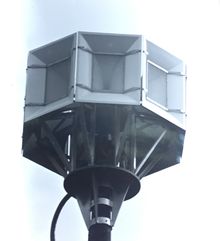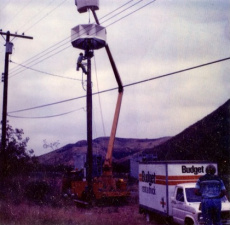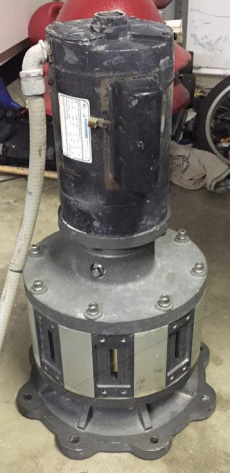Southern California Edison Model 120
| Southern California Edison Model 120 | |
[[File: |200px]] |200px]]
| |
| Company | Southern California Edison |
|---|---|
| Produced | 1983 and 1988 |
| Type | Pneumatic |
| Sound output | 120 |
The SoCal Edison (SCE) 120 or Model 120 was a 120 dB low tone pneumatic siren designed in house by Southern California Edison for use within the 10 Mile Emergency Planning Zone (EPZ) for the San Onofre Nuclear Generating station .
History
There were 22 of these sirens produced with one being never installed which is now privately owned. 16 were installed in July 1983 to add into a system of 39 Federal Signal STL-10's that were installed in April 1982, 8 of which indirectly swapped out with Model 120s with another 8 installed as new locations, and later in 1988 5 additional locations were installed, one of which replacing a Thunderbolt that was actually a CD siren used by one of the cities before SCE took over it for use in their siren system.
The reason these sirens were made is because there was no other siren available that would meet the plants needs, the system first started out with Sentry Siren Incorporated 10V's, 5V's, and 3V8's installed in August 1981 and was tested January 25th thru 27th, 1982 and proved to preform extremely poorly and the discussion was made to swap the 39 Sentries out for STL-10s by April 1982 with testing of them commencing by May the same year. STL-10 performance was significantly better, but still not good enough coverage wise. The only sirens that were available on the market that have the range the plant was looking for were rotating directional sirens only, of which the plant wanted Omnidirectional only sirens. So the decision was made to design their own siren.

Starting in around June 1982, Model 120 prototypes started to be constructed and tested, with the final designed units being completed in March 1983, originally the plan was after the Model 120s were installed, a now total of 52 sirens were going to be all Model 120s which means swapping out the remaining STL-10s with 120s making the system Model 120's only, but this plan was dropped shortly afterwards and only about 8 Model 120s ended up swapping out STL-10s with the other ones being new locations that didn't replace STL-10s.
This was due to the whole siren thing causing delays to the plant by not having a ready siren system by 1981 which was the original year for the plants 2 new reactors that just finished construction, Units #2 and #3 to begin operation, but due to the Sentries originally bought not meeting the plants needs by not effectively covering the EPZ, and the STL-10s still not being good enough, they had to find another siren that meets the plants needs in order for the plants new reactors to start operations which caused a delay for over a year, this also happened around the same time the NRC required Nuclear plants to have siren systems, but until SONGS get sirens that can perfectly cover the 10 mile EPZ, the plants new reactors could not begin operations, and the plants original reactor that was the first reactor to be built in 1968 (Decommissioned in 1992 and completely demolished by 2006) Unit #1 could not be restarted until the siren system is fully operational and effectively covers the EPZ.
So after the Model 120s went up, to end the delays of the siren system not being up to par, which costed over $1 million per day that held up the plant from starting, it was decided to just keep the STL-10s and just add 21 Model 120s in areas that need coverage to get the EPZ effectiveness up to code for the plants original reactor to restart, and the new reactors to start. After a successful system test in July 1983, the plants new reactors began operation shortly afterwards with Unit #2 starting on August 8th, 1983, and Unit #3 on April 1st, 1984, as well as Unit #1 restarted.
Other Information
For around a decade, they were thought to be "Toshiba" sirens, because they were pneumatic and people just assumed they were made by Toshiba, who also made pneumatic sirens. The Model 120 is a Pneumatic siren, meaning it requires an external air source to produce sound. The sound is chopped by a rotor, which sits inside a hollow cylinder, or stator, which acts as a chamber to contain the air inside. 8 Small narrow slots on the stator allow the sound to come out. The sound is then projected by 8 large fiberglass horns. It consists of a belt driven Paxton blower, that uses a 10 Hp TEFC motor. The rotor is 9.75 inches in diameter and has 5 ports. Including the stator it is in total 11.75 inches in diameter. The rotor is powered by a 2 Hp TEFC motor that spins at 3600 RPM.
By 6/10/2004, the plant was discussing a system replacement project due to saying the current system is "aging", and a year later starting In November 2005, (a month after the annual siren test), the Model 120s and the STL-10s started to be gradually removed and replaced, and by Febuary 2006 all have been replaced marking October 26th, 2005 as the final test of the original system, as well as the end of the one of a kind original system that stood out from all other Nuclear plant systems. Whelen WPS 2810s and WPS 2806s were installed in their places. The 2810s went in place of the Model 120s and the 2806s went in place of the STL-10s.
These new electronic sirens have battery backup, are less maintenance, and having similar ranges to the original system such as the 2806s having better range compared to the STL-10s, and the 2810s having close to the same range but about 2,000 feet less range compared to the the Model 120, but still enough range to cover the EPZ, and as for the strict requirements of the original system, that was no longer an issue as by the 2000s there was commercially produced omnidirectional sirens that have close to the same range as the Model 120 and as well have better range then the STL-10s.
After all the old sirens have been removed and replaced, SONGS sold 23 of the STL-10s to Curry County Oregon to be used as tsunami sirens, and the Model 120s and remaining 5 STL-10s are believed to have been scrapped, but its unknown if they were, or went somewhere else but hasn't been discovered. The only Model 120 that is known and remaining is in the possession of Aaron Allevato (Duderocks5539) and Edaan Friedman and currently under restoration to be brought back into operating condition.

See Also
- Siren patent: https://patents.google.com/patent/US4649853
- Model 120 head run up: https://www.youtube.com/watch?v=mf7YC0Vc_ZI
- Model 120 head dissembled: https://www.youtube.com/watch?v=yOcVk3SrqtY